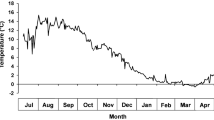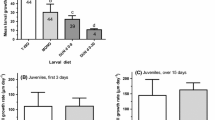Abstract
We maintained 30 to 35 mm sea urchins (Strongylocentrotus droebachiensis) on 17 different macroalgal diets in the field over a 130-d period and correlated the resulting changes in somatic and gonadal tissues with measures of food preferences. The varions algae fell into there distinct categories according to their ability to support growth. The most striking effect of diet was on gonadal mass, there being a 14-fold increase for the best algal diet, compared to initial gonadal mass, and nearly a threefold decrease for the worst diet. The relation of food preference to somatic growth was nonlinear. A sharp increase in the growth of test diameter, total mass and test mass occurred between the nonpreferred and intermediately preferred algae, but growth rates were similar for intermediate and preferred algae. Gonadal growth tended to increase exponentially with an important measure of food preference, feeding rate (g ingested d−1). These observations suggested that urchins only channel food resources into somatic growth up to a given point, additional reserves being used for producing gametes. The positive relationship of food preference to growth, and especially the strong correlation with gonadal production, indicates that the highly selective feeding of the urchin contributes to ils fitness.
Similar content being viewed by others
References
Carefoot TH (1967) Growth and nutrition ofAplysia punctata feeding on a variety of marine algae. J mar biol Ass UK 47: 565–589
Ebert TA (1982) Longevity, life history, and relative body wall size in sea urchins. Ecol Monogr 52: 353–394
Foreman RE (1977) Benthic community modification and recovery following intensive grazing byStrongylocentrotus droebachiensis. Helgoländer wiss Meeresunters 30: 468–484
Hagen NT (1983) Destructive grazing of kelp beds by sea urchins in Vestforden, northern Norway. Sarsia 68: 177–190
Hair JF, Anderson RE, Tatham RL, Black WC (1992) Multivariate data analysis with readings, 3rd edn. MacMillan Publishing Company, New York
Hay ME, Fenical W (1988) Marine plant-herbivore interactions: the ecology of chemical defense. A Rev Ecol Syst 19: 111–146
Himmelman JH (1969) Some aspects of the ecology ofStrongylocentrotus droebachiensis in eastern Newfoundland. M.Sc. thesis, Memorial University of Newfoundland, St. John's
Himmelman JH (1978) Reproductive cycle ofStrongylocentrotus droebachiensis. Can J Zool 56: 1828–1836
Himmelman JH (1984) Urchins feeding and macroalgal distribution in Newfoundland, eastern Canada. Naturaliste Can 111: 337–348
Himmelman JH (1986) Population biology of urchins on rocky barrens. Mar Ecol Prog Ser 33: 295–306
Himmelman JH, Cardinal A, Bourget E (1983) Community development following removal of urchins,Strongylocentrotus droebachiensis, from the rocky subtidal zone of the St. Lawrence Estuary, eastern Canada. Oecologia 59: 27–39
Himmelman JH, Nédéléc H (1990) Urchin foraging and algal survival strategies in intensely grazed communities in eastern Canada. Can J Fish aquat Sciences 47: 1011–1026
Himmelman JH, Steele DH (1971) Foods and predators of the green sea urchinStongylocentrotus droebachiensis in Newfoundland waters. Mar Biol 9: 315–322
Hurlbert SH (1984) Pseudoreplication and the design of ecological field experiments. Ecol Monogr 54: 187–211
Keats DW, South GR, Steele DH (1990) Effects of an experimental reduction in grazing by green sea urchins on a benthic macroalgal community in eastern Newfoundland. Mar Ecol Prog Ser 68: 181–193
Keats DW, Steele DH, South GR (1983) Food relations and short terra aquaculture potential of the green sea urchin (Strongylocentrotus droebachiensis) in Newfoundland. Tech Rep meml Univ Newf Mar Sci Res Lab 24: 1–24
Keats DW, Steele DH, South RL (1984) Depth-dependent reproductive output of the green sea urchin,Strongylocentrotus droebachiensis (O.F. Müller), in relation to the nature and availability of food. J exp mar Biol Ecol 80: 77–91
Larson BR, Vadas RL, Keser M (1980) Feeding and nutritional ecology of the sea urchinStrongylocentrotus droebachiensis in Maine, USA. Mar Biol 59: 49–62
Lima SL, Dill LM (1990) Behavioral decision made under the risk of predation: a review and prospectus. Can J Zool 68: 619–640
Lowe EF, Lawrence JM (1976) Absorption efficiencies ofLytechinus variegatus (Lamarck) (Echinoderata: Echinoidea) for selected marine plants. J exp mar Biol Ecol 21: 223–234
Miller RJ, Mann KH (1973) Ecological energetics of the seaweed zone in a marine bay on the Atlantic coast of Canada. III. Energy transformations by sea urchins. Mar Biol 18: 99–114
Propp MV (1977) Ecology of the sea urchinStrongylocentrotus droebachiensis of the Barents Sea: metabolism and regulation of abundance. Biol Morya, Kiev 1: 39–51
Pyke GH, Pulliam HR, Charnov EL (1977) Optimal foraging: a selective review of theory and tests. Q Rev Biol 52: 137–154
Scheibling RE, Stephenson RL (1984) Mass mortality ofStrongylocentrotus droebachiensis (Echinodermata: Echinoidea) off Nova Scotia, Canada. Mar Biol 78: 153–164
Schoener TW (1971) Theory of feeding strategies. A Rev Ecol Syst 2: 369–404
Sierszen ME (1990) Variable selectivity and the role of nutritional quality in food selection by a planktonic rotifer. Oikos 59: 241–247
Sih A (1987) Predators and prey lifestyles: an evolutionary and ecological overview. In: Kerfoot WC, Sih A (eds) Predation: direct and indirect impact on aquatic communities. University Press of New England, Hanover, N.H., pp 203–224
Vadas RL (1968) The ecology ofAgarum and the kelp bed community. Ph.D. thesis, University of Washington, Seattle, Wash.
Vadas RL (1977) Preferential feeding: an optimization strategy in sea urchins. Ecol Monogr 47: 337–371
Zar JH (1984) Biostatistical analysis, 2nd edn. Prentice-Hall, Englewood Cliffs, N.J.
Author information
Authors and Affiliations
Additional information
Communicated by R.J. Thompson, St John's
Rights and permissions
About this article
Cite this article
Lemire, M., Himmelman, J.H. Relation of food preference to fitness for the green sea urchin,Strongylocentrotus droebachiensis . Mar. Biol. 127, 73–78 (1996). https://doi.org/10.1007/BF00993646
Received:
Accepted:
Issue Date:
DOI: https://doi.org/10.1007/BF00993646




